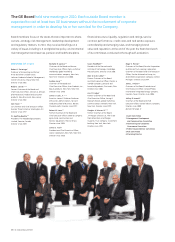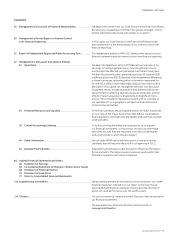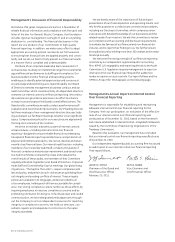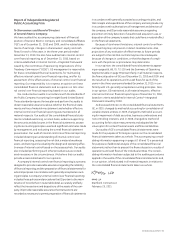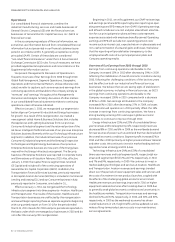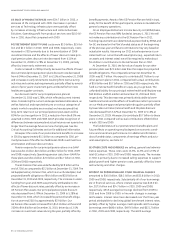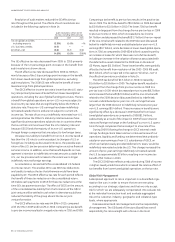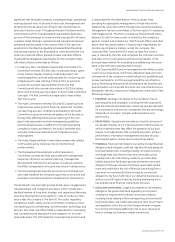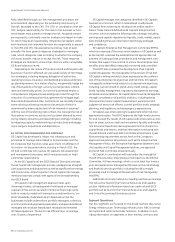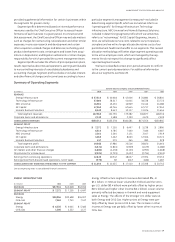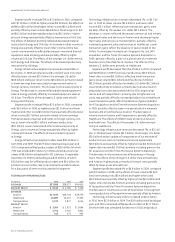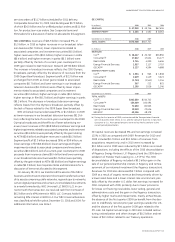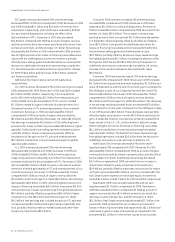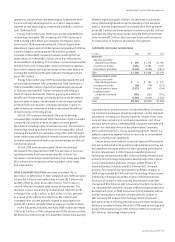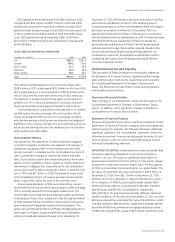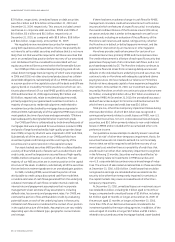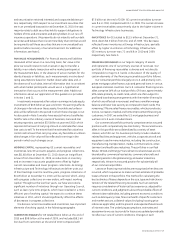GE 2010 Annual Report Download - page 39
Download and view the complete annual report
Please find page 39 of the 2010 GE annual report below. You can navigate through the pages in the report by either clicking on the pages listed below, or by using the keyword search tool below to find specific information within the annual report.management’s discussion and analsis
GE 2010 ANNUAL REPORT 37
significant risks facing the company, including strategic, operational
and reputational risks. At the end of each year, management and
the Board jointly develop a list of major risks that GE plans to
prioritize in the next year. Throughout the year, the Board and the
committees to which it has delegated responsibility dedicate a
portion of their meetings to review and discuss specific risk topics
in greater detail. Strategic, operational and reputational risks are
presented and discussed in the context of the CEO’s report on
operations to the Board at regularly scheduled Board meetings
and at presentations to the Board and its committees by the vice
chairmen, chief risk officer, general counsel and other officers.
The Board has delegated responsibility for the oversight of spe-
cific risks to Board committees as follows:
• In February 2011, the Board created a Risk Committee. This
Committee oversees GE’s key risks, including strategic, opera-
tional, market, liquidity, funding, credit and product risk
and the guidelines, policies and processes for monitoring and
mitigating such risks. Starting in March 2011, as part of its
overall risk oversight responsibilities for GE, the Risk
Committee will also oversee risks related to GECS (including
GECC), which previously was subject to direct Audit Committee
oversight. The Risk Committee is expected to meet at least
four times a year.
• The Audit Committee oversees GE’s and GE Capital’s policies
and processes relating to the financial statements, the finan-
cial reporting process, compliance and auditing. The Audit
Committee receives an annual risk update, which focuses on
the key risks affecting GE as well as reporting on the com-
pany’s risk assessment and risk management guidelines,
policies and processes. In addition to monitoring ongoing
compliance issues and matters, the Audit Committee also
annually conducts an assessment of compliance issues
and programs.
• The Public Responsibilities Committee oversees risks related
to GE’s public policy initiatives, the environment and
similar matters.
• The Management Development and Compensation
Committee oversees the risks associated with management
resources, structure, succession planning, management
development and selection processes, including evaluating
the effect compensation structure may have on risk decisions.
• The Nominating and Corporate Governance Committee over-
sees risks related to the company’s governance structure and
processes and risks arising from related person transactions.
The GE Board’s risk oversight process builds upon management’s
risk assessment and mitigation processes, which include stan-
dardized reviews of long-term strategic and operational planning;
executive development and evaluation; code of conduct compli-
ance under the Company’s The Spirit & The Letter; regulatory
compliance; health, safety and environmental compliance; finan-
cial reporting and controllership; and information technology and
security. GE’s chief risk officer (CRO) is responsible for overseeing
and coordinating risk assessment and mitigation on an enter-
prise-wide basis. The CRO leads the Corporate Risk Function and
is responsible for the identification of key business risks,
providing for appropriate management of these risks within
stated limits, and enforcement through policies and procedures.
Management has two committees to further assist it in assessing
and mitigating risk. The Policy Compliance Review Board meets
between 10 and 14 times a year, is chaired by the company’s
general counsel and includes the chief financial officer and other
senior level functional leaders. It has principal responsibility for
monitoring compliance matters across the company. The
Corporate Risk Committee (CRC) meets at least four times a
year, is chaired by the CRO and comprises the Chairman and CEO
and other senior level business and functional leaders. It has
principal responsibility for evaluating and addressing risks esca-
lated to the CRO and Corporate Risk Function.
GE’s Corporate Risk Function leverages the risk infrastructures
in each of our businesses, which have adopted an approach that
corresponds to the company’s overall risk policies, guidelines and
review mechanisms. In 2010, we augmented the risk infrastruc-
ture by formalizing enterprise risk ownership at the business unit
level and within our corporate functions. Our risk infrastructure is
designed to identify, evaluate and mitigate risks within each of the
following categories:
• STRATEGIC. Strategic risk relates to the company’s future
business plans and strategies, including the risks associated
with the markets and industries in which we operate, demand
for our products and services, competitive threats, technology
and product innovation, mergers and acquisitions and
public policy.
• OPERATIONAL. Operational risk relates to the effectiveness of
our people, integrity of our internal systems and processes, as
well as external events that affect the operation of our busi-
nesses. It includes product life cycle and execution, product
performance, information management and data security,
business disruption, human resources and reputation.
• FINANCIAL. Financial risk relates to our ability to meet financial
obligations and mitigate credit risk, liquidity risk and exposure
to broad market risks, including volatility in foreign currency
exchange rates and interest rates and commodity prices.
Liquidity risk is the risk of being unable to accommodate
liability maturities, fund asset growth and meet contractual
obligations through access to funding at reasonable market
rates and credit risk is the risk of financial loss arising from a
customer or counterparty failure to meet its contractual
obligations. We face credit risk in our industrial businesses, as
well as in our GE Capital investing, lending and leasing activi-
ties and derivative financial instruments activities.
• LEGAL AND COMPLIANCE. Legal and compliance risk relates to
changes in the government and regulatory environment,
compliance requirements with policies and procedures,
including those relating to financial reporting, environmental
health and safety, and intellectual property risks. Government
and regulatory risk is the risk that the government or regula-
tory actions will impose additional cost on us or cause us to
have to change our business models or practices.



